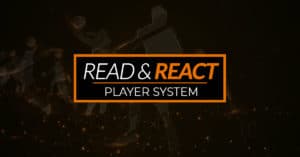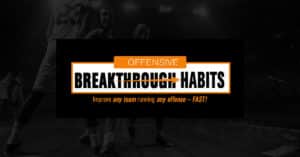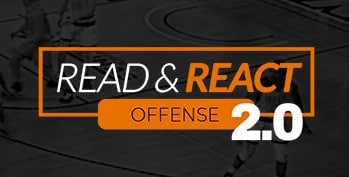The one component of basketball which I see slowly deteriorating in basketball is rebounding. Not only is the “scoring” mindset attributing to this, but a lot of players think that once a shot goes up the possession is over (both offensively and defensively).
In terms of offensive rebounding, my philosophy is very simple. Unless you are the player(s) responsible for getting back on defense after a shot goes up, you MUST crash the boards. Let me clarify, there is a difference between crashing the boards and simply making a step or two toward the rim. Crashing means fighting your way to the rim (even if you are blocked out) to get your hands on the ball. I do not even mind if my players occasionally get a foul called on them attempting to offensive rebound, that is a good sign (usually) that they are hungry for the ball.
On the other hand, defensive rebounding takes a little more skill. Some players think that just because they are not very tall, that they cannot be a great rebounder. Point them toward the All-Time leading rebounder in the NBA since 1973, Dennis Rodman. Rodman, at 6’6″, averaged 13.1 rebounds per game over his illustrious 14 season career in the NBA.
It is not about how big you are, it is about technique, studying misses, and drilling. Let’s start by going through the technique.
Rebounding Technique
When a shot goes up too many players do the rainbow neck and just watch the ball float toward the rim having no clue where their man is. Once the ball is released, the first thing to do is find the closest man near you to block out. It does not matter if it is your man or not, block them out!
This next part is where a lot of players get beat on the boards. Players think it is enough to just find their man, turn their back to them, and “butt out” (the process of trying to block out simply using your backside). A great block out is one which causes the offensive player to second guess crashing the boards in the future. One great block out can set the tone for the remainder of the game. I learned this intimidating technique from University of Wyoming Head Coach, Larry Shyatt.
- Find the man you are blocking out and put yourself between him and the basket getting into an athletic stance. Attack the offensive, do not let the offense attack you.
- Take your prominent forearm and hit the offensive player (like an arm-bar) across the thigh(s). This will take away their legs and prevent them from jumping. Once technique is taught, avoid hard hits in practice to prevent injuries to your own team.
- Now that you have them “stunned”, quickly pivot and start backing your man away from the basket.
- Do not stop blocking out until the ball is secured. If the ball is coming towards you, release your block out and jump with extended arms grabbing the ball out of the air with TWO hands!
One great indicator that your team blocked out is that the basketball is allowed to hit the floor before it is rebounded. We are not saying you should let the ball hit the floor, players should attack the rim to grab rebounds. The point is that if all 5 players do their job, the ball should be able to hit the floor around the rim.
Once the ball is rebounded your job is not over yet, you need to secure the ball and find your outlet. Securing the ball contains two elements:
- Chin the ball with your elbow high and out. Placing the ball at your waist or above your head makes it vulnerable to pesky guards and other bigs.
- Be STRONG with the ball. No one should be able to slap it out of your hands.
Officials now are getting quicker and quicker to call an elbow-throwing violation after a rebound. As a result, many “old-school” coaches dispute that that is a part of basketball and that officials are taking fundamentals away from the game. I disagree. A fundamental rebound is not chinning the ball and start swinging your elbows at any offensive player that gets near you.
In my 28 years on Earth, I have never been taught to throw an outlet pass to my guards without pivoting first so both players can see each others #’s (on front of jersey). Therefore, a simple outside pivot with your elbows high makes any contact a foul on the offense for violating your space. Unless of course, you continue to swing your elbows after you finish pivoting.
Studying Misses
One component that made Rodman the best rebounder in NBA history, was his ability to read the basketball and know where and how the ball was coming off the rim. This allowed him to anticipate misses before his opponents and get himself into the correct position under the rim for the rebound. Many of his teammates have said that Rodman spent hours upon hours studying his opponents to learn tendencies on where their shots typically missed from different parts of the floor. I came across this article written in 2006 that discusses Dennis Rodman’s philosophy on rebounding. He offers an interesting insight on his thoughts of blocking out as an undersized big man.
One great assignment to give yourself every Off-Season (or chart it during the Season) is to break down the court into to areas below.

- Develop a database of where you are giving up your shots on defense and where you are taking your shots on offense.
- Allows you to create a tendency database of where those shots are missed and where the ball is rebounded.
- Shows you if you are a weak rebounding team on certain areas of the floor.
To keep things organized, I would recommend creating a different chart for each area of the floor. This will make it much easier to read. Below is an example if you were chart the shots from the right corner while your team is on defense.
How do you become a great rebounding team? Drill-Drill-Drill!. The great part about rebounding drills is that they are not just drills for the defense, but they are also great to encourage offensive rebounding. Every player wants to be on offense as long as possible. Forcing the offense to crash the boards will not only make the block out situations more game-like; but it also encourages the emphasis of offensive rebounding.
War 1-on-1

I recommend starting this drill 1-on-1 first. Start with one rebounder (X1) with their head just in front of the rim and the first offensive rebounder at the elbow opposite the coach with the ball. Place the rest of the team in a line; they are all on offense. Once the coach shoots the ball, X1 must block out 1 and rebound the ball. The play is not over until X1 has secured the ball. The only way for X1 to get out of the drill is to make five consecutive stops (The offense cannot rebound the ball). The number is interchangeable but five is a good starting point.
War 2-on-2

The clocks starts once the coach shoots the ball. X1 and X2 are responsible for blocking out 1 and 2 respectively. If the defense rebounds the ball, they receive one point. If the offense rebounds the ball, the drill is not over; they must score in order to receive a point. At this point the drill is still not over, the offense should attempt to grab as many rebounds as possible and score as many points as possible. The drill is not over until the defense secures the basketball.
Once the buzzer sounds and the current group finishes, keep the scores up on the board and flip offense to defense. Put another four minutes back up on the clock and start the drill again. Remember, the team now on offense was just on defense and vice versa, so make sure you are still giving points to the correct team. (i.e.: If at the end of the first four minutes the offensive team {Team A} scored 11 points, once they become the defense their first defensive rebound would get {Team A} 12 points and so on).
If there is a high intensity level, keep the drill going and go through another session. Once you are satisfied with your team’s effort tally up the scores. Let the winning team grab water first while the losing team runs.
Circle the Wagons

Another way to utilize this drill and is to use it to work on your offense as well. If the offense rebounds the ball, either score quickly or if you don’t have anything pass the ball back to the coach and the defense will start circling the wagons again. Once the defense (Team A) rebounds the ball, the offense (Team B) steps off as the ball is outlet passed and pushed up the floor. Either score out of your Early Offense or run a set 5 vs. 0. On the way back down the court, Team A will now run their offense versus Team B. The play is dead once Team A scores or Team B secures a rebound. Flip the teams around and start the drill again.








